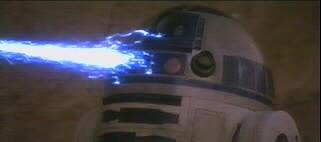


Although ion cannons are more clearly understood than turbolasers, official sources consistently describe them incorrectly. Timothy Zahn (as well as the creators of all the X-wing computer games) described ion cannon bolts as being blue beams. He also wrote about their inadequacies in planetary defense. Yet, in The Empire Strikes Back, we see that these weapons are more than adequate for planetary defense, and they do not fire blue beams.
The EGW&T states on page 84 that:
Ion cannons are similar to laser cannons, but their energy beams, which appear to be standard laser blasts, actually disable the targeted ship's electronic and computer systems instead of causing physical damage. However, in the next sentence, it states that the weapon causes overloads, "blowing out computers". If a computer console is "blown out", it is damaged, is it not? This is a clear contradiction. The book also says that "ion blasts are unimpaired by energy shields": ...ships have no defense against them short of reconfiguring their shields - and this would make the shields useless for absorbing standard laser blasts. However, in The Empire Strikes Back, we neither see nor hear any evidence that indicates the Star Destroyers in orbit above Hoth modified their shields in any way. |
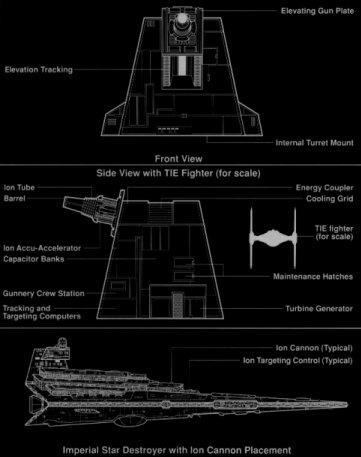 |
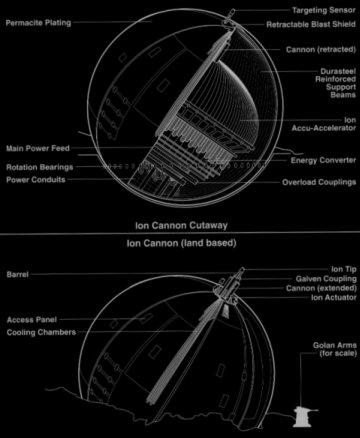 |
Page 98 discusses planetary defense ion cannons. It labels the Rebel ion cannon in TESB as a
"Kuat Drive Yards v-150 Planet Defender" and states it is a "typical planetary ion
cannon". It states:
The v-150 consists of a spherical permacite shell, and its power is supplied by a massive reactor that is normally buried nearly forty meters below ground level. When it is activated, it takes several minutes to maneuver the ion cannon into position on its rotating base, while the blast shield retracts, exposing the cannon. A crew of twenty-seven soldiers is needed to operate the weapon and handle its targeting computers. There are some problems with this description. First, why does the reactor need to be buried 40 meters underground, so that it is not readily serviced? Why isn't the reactor located in that huge "permacite" sphere? We never see the cannon barrel itself retracted in The Empire Strikes Back. The text neglects to mention that the cannon's fire is coordinated from inside the base, nowhere near the cannon itself (remember the lady who said "Stand by, ion control ... fire"). |
And why does it take several minutes to maneuver the cannon? The same book on the same page explains that the quickness of these guns is essential for planetary defense:
Ion cannons are often used to supplement planetary shields, which take several minutes to activate and are impractical to maintain at all times because of their tremendous energy demands. Since enemy ships often appear without warning, planets rely on ion cannons and similar weapons, such as planetary turbolasers, to provide covering fire until the shields can be raised.
This is another inconsistency on one page, almost directly accross the page in twin columns! This is very representative of official sources. The writers are incredibly creative, but did very little research, and it shows in their work.
A quick look at the scene in The Empire Strikes Back reveals more precise features of this type of weaponry. The shield protecting the Hoth base is lowered. A transport and two fighter escorts have left the surface of the planet, and enter orbit, just as the shield is lowered (an aside: this tells us something about shielding. The shield had to be lowered to allow the ships to leave. This shield was described as an "energy shield" by an Imperial officer. This shield was impenetrable by available Imperial weapons. So much for the separate energy/ray shields invented by West End Games). A woman in front of a console speaks into a comlink, instructing the ion cannon crew to fire. The cannon fires several shots, and at least two bolts hit the ISD Tyrant.
The EGW&T states this is the ISD Avenger, but that is not likely. My associate Anthony Tully argues this point best:
This ship is the ISD Tyrant, not the ISD Avenger, notwithstanding what the novelization says. Reasons:
- The model is Devastator-class, definitive internal proof she's not the Avenger.
- The captain is not Captain Needa, but a more wedge-faced man.
- This man is accurately identified in a card as captain of the "Tyrant" and the "Tyrant" itself is named.
- Avenger is known to be the pursuing ISD in the "triple" ISD collision scene (note Captain Needa on the bridge).
He goes on to say that it is unlikely that the ship hit by the ion cannon was in this collision, as its engines went dark, and the ship was out of control. It would be unable to catch up with the destroyers already heading away at full acceleration.
| In these images, we can see the true color of ion bolts. The front tip is white, which fades
into yellow, orange, and purple along the length on the bolt. There is no blue to be seen
in the bolt.
The widest part of the bolt is the front tip, and it tapers down to a point, then widens abruptly, then tapers down again quickly to a point. This is very similar to the shape of turbolaser bolts, except that the entire tapering/expanding takes place over a much shorter length, relative to the size of the bolt. The ion bolt also has a tail at least as long as the "peanut-shaped" front end. This tail apparently begins at about two-thirds of the length of the first enlargement, and continues with consistent width to a certain distance, then quickly tapers off to a point. The velocity of these bolts is unknown, but it is only a few hundred meters per second faster than the transport's current velocity. It is definitely traveling at low sublight speeds. The bolt's diameter is approximately equal to, but slightly larger than that of the bulb on top of the transport. |
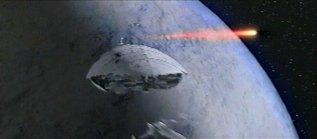
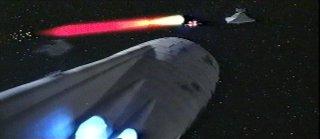 |
| These images show the first fractions of a second after the first visible impact. A glow is seen away from the hull of the vessel. This glow is white and purple, similar to the first and last stages of the bolt (seen in an image above). |
 
 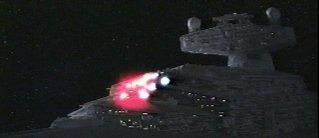 |
| In these images, the white and purple glow turns partially yellow. Then, the white glow
gradually comes into contact with the hull of the vessel.
The logical conclusion is that the ion bolt took some fraction of a second to defeat the ISD's shields, and then finally contacts the hull. |
 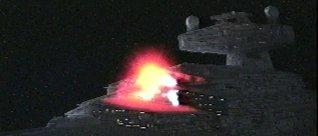
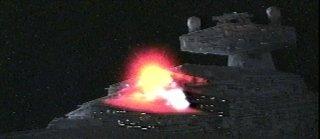  |
The bolt sticks to the shield for a fraction of a second (as opposed to being deflected as turbolaser bolts are), then penetrates to the hull, and spreads over the surface of the hull in a chaotic fasion. This disproves the "common knowledge" belief that ion bolts are unaffected by shields, and pass through unhindered.
| In these images, the white glow makes full contact with the hull and spreads over the surface in several directions. | 
 |
Note that the purple and yellow glows are gone in the last image. The significance of this is unknown. Perhaps this signals the complete loss of shielding in the area?
 |
This image shows the white glow dissipating, as it spreads farther over the vessel's hull. Note
that the glow is not consistently spread over this section of the vessel's hull. The original
location of the glow is still present, but at least three other areas have begun glowing, and
spreading farther along the hull.
Perhaps the path of this glow indicates the most conductive areas of the hull? Also note that the bolt hit on the starboard side of the vessel, but the glow is propagated on the port side. |
 |
This image is a few frames later, when the new bolt in the image above hits. This is the
instant of impact. The bolt is visibly striking the shield a few meters from the hull. This
provides a possible scaling opportunity for the size of the bolt.
Note that the tail of the bolt has not contacted yet. Also note that the last bolt is mostly dissipated, leaving only the odd propagation on the port side of the ship. |
Also of interest is the fact that the ship has already been hit by a powerful ion bolt that defeated the shields; but this second bolt is meeting resistance as well. This must indicate that ISDs have either isolated or redundant shield systems. Perhaps the conning tower has its own dedicated shield system?
Jawas carry weapons that appear to be miniature ion cannons (like a blaster versus a turbolaser). They are described as a souped-up restraining bolt, but this is clearly not the case. They discharge a bolt of some kind, leave much smoke at the barrel, and have a similar effect to ion cannon bolts.

